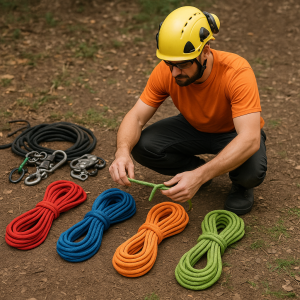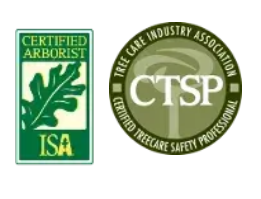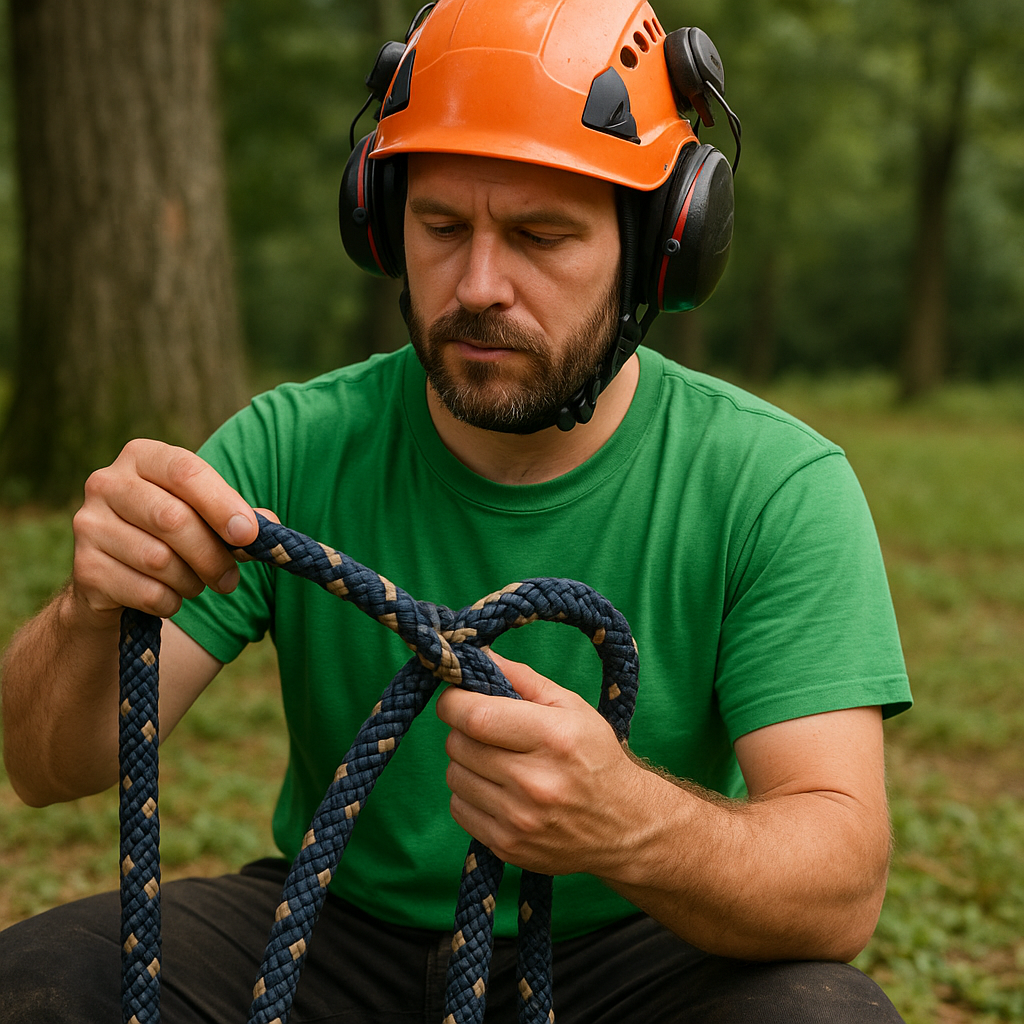The Climber’s Guide to Rope Selection: 5 Ropes Every Pro Should Know
Climbing Rope: Listen up, climbers. After fifteen years of hauling myself up everything from 200-foot redwoods to storm-damaged oaks in Lancaster’s windiest neighborhoods, I’ve learned that your rope isn’t just gear – it’s your lifeline, your partner, and sometimes your best friend when you’re 80 feet up dealing with a widow-maker.
But here’s the thing that drives me nuts: I still see climbers treating rope selection like they’re picking out a garden hose. “Rope is rope,” they say. Well, let me tell you something – that attitude will get you hurt, cost you money, or worse, cost you your reputation when that perfect limb removal turns into a property damage nightmare because you used the wrong line for the job.
So let’s talk about the five ropes that should be in every serious climber’s arsenal, and more importantly, when and why you’d choose each one.
The Workhorse: 11.7mm Static Climbing Line
This is your bread and butter, your daily driver. I’ve been running the same brand of 11.7mm static line for three years now, and it still inspects clean after thousands of climbs. The diameter gives you the perfect balance – thick enough to grip comfortably during long pruning sessions, but not so chunky that it weighs you down or fights you on redirect.
Here’s what most guys don’t realize: that extra 0.2mm over an 11.5mm line makes a real difference when you’re working 8-hour days. Your hands stay fresher, your grip stays confident, and you’re not fighting rope burn through your gloves by lunch.
I use this line for probably 70% of my climbs – routine pruning, dead wooding, basic removals where I’m not dealing with massive pieces. It handles body-weight loads all day long without stretching out, and the low-stretch characteristics mean your positioning stays predictable.
Pro Hack: Mark your static line every 10 feet with colored tape. When you’re setting up complex rigging, you can call down exact measurements to your ground crew without having to estimate. “Send me 30 feet of line” hits different when you know it’s exactly 30 feet.
The Smooth Operator: 11mm Dynamic Climbing Line
Now, this is where things get interesting, and where I see a lot of climbers make mistakes. Dynamic rope has stretch built into it – usually 8-12% under working loads. Some guys avoid it because they think stretch equals unpredictable. Those guys are missing out.
Dynamic rope shines in two specific situations: when you’re doing a lot of aggressive pruning where you might shock-load the line, and when you’re working in cold weather. That built-in stretch acts like a shock absorber for both you and your anchor points.
I learned this lesson the hard way during a December storm cleanup. I was using my regular static line in 25-degree weather, and the rope felt like climbing a steel cable. Every movement jarred my joints, and by the end of the day, I felt like I’d been hit by a truck. Switched to dynamic the next day, and it was like climbing on a completely different planet.
The downside? That stretch can work against you during precision cuts. If you’re trying to position yourself exactly 18 inches from a delicate branch, that stretch can throw off your spacing. Know when to use it.
The Heavy Hitter: 13mm Rigging Line
When the job calls for moving serious weight, this is your go-to. I’m talking about pieces over 500 pounds, complex rigging scenarios, or any time you’re dealing with forces that would make your regular climbing line nervous.
The thing about 13mm rigging line is that it’s not just about strength – though the working load limit is substantially higher. It’s about heat dissipation and wear resistance. When you’re lowering a 800-pound oak limb and that rope is running hot through your friction device, that extra diameter spreads the heat across more surface area.
I’ve seen guys try to save money by using their climbing line for rigging work. It’s a false economy. You’ll burn through $300 worth of climbing rope trying to save $150 on proper rigging line.
What Went Wrong: Last spring, I watched a crew try to lower sections of a massive cottonwood using 11mm line. The rope didn’t break, but it got so hot during the lower that it glazed the sheath. That rope went from trustworthy to trash in one job. The kicker? They had proper rigging line on the truck but didn’t want to “waste time” switching over.
The Precision Tool: 10mm Throwline-Compatible Climbing Line
This is a newer addition to my kit, and honestly, it’s changed how I approach certain jobs. When you’re dealing with complex canopy work where you need to set multiple points quickly, having a climbing line that doubles as heavy-duty throwline is a game-changer.
The 10mm diameter means it’s light enough to throw accurately with a throw bag, but strong enough to climb on once it’s set. I use this primarily for storm damage cleanups where I need to get multiple lines set quickly in compromised trees.
The learning curve is real, though. The smaller diameter means your standard friction devices might not grab quite the same way. I had to adjust my technique and, in some cases, add extra wraps to get the same control I’m used to with thicker lines.
The Specialist: Hollow-Braid Rigging Line
This one’s for the gear heads and the guys who do a lot of technical rigging. Hollow-braid construction lets you splice eyes directly into the rope without any hardware. The result is a connection that’s stronger than the rope itself and creates no stress concentrations.
I primarily use hollow-braid for permanent installations – like cabling systems or complex rigging setups that need to stay in place for extended periods. The splice work takes practice, but once you get it down, you can create custom-length slings and rigging configurations that would be impossible with standard rope.
The downside is cost and availability. Hollow-braid rigging line typically runs 30-40% more than standard construction, and not every supplier keeps it in stock.
Choosing the Right Rope for the Job
Here’s the reality check: the best rope is the one that matches your specific situation. I’ve got all five types on my truck because different jobs demand different tools. A simple residential pruning job doesn’t need 13mm rigging line, and trying to handle a complex removal with basic climbing line is asking for trouble.
Consider the tree species, the size of the pieces you’ll be handling, weather conditions, and the complexity of the work. A mature Lancaster live oak removal in July requires different rope considerations than a palm tree cleanup in January.
Maintenance Reality
No matter which rope you choose, remember that rope is a consumable item. I inspect my lines before every job, and I retire them based on actual condition, not just age. A rope that’s been used gently for two years might still have life left, while a rope that’s seen six months of heavy rigging might be ready for retirement.
Keep detailed records of your rope usage. Note which jobs were particularly hard on the gear, and track any incidents that might have compromised the rope’s integrity. Your insurance company will appreciate the documentation, and your body will appreciate the peace of mind.
The bottom line? Invest in quality rope appropriate for your work, learn to inspect it properly, and don’t be afraid to retire it when it’s time. Your career depends on making good decisions about the gear that keeps you safe and productive.

Create a rope log for each line in your kit. Track purchase date, major jobs, inspection results, and retirement date. This data helps you predict rope lifespan and budget for replacements.
FREQUENTLY ASKED QUESTIONS
What’s the difference between climbing rope and rigging rope—and can I just use one for both?
Nope, and please don’t. Climbing ropes are designed to support you—your body weight, movement, positioning. Rigging ropes are built to handle dynamic loads like swinging limbs, shock loads, and friction from lowering systems. Use a climbing rope for rigging and you’ll wear it out fast—or worse, risk failure under load. Think of them as different tools in the same kit: both critical, but with very different jobs.
How do I know when a rope needs to be retired?
It’s not just about age—it’s about condition. Look for sheath glazing, flat spots, core herniation, or anything that makes the rope feel stiff or spongy. If you’ve used it for a big rigging job or after any fall or shock load, inspect it immediately. Pro move? Keep a rope log. Track purchase dates, big jobs, and inspections. If you’re guessing whether a rope is safe, it’s probably not.
Do I really need multiple ropes, or can one do it all?
If you’re serious about safety, efficiency, and not trashing your gear every few jobs—you absolutely need more than one. Just like you wouldn’t use a chainsaw to finish pruning cuts, you don’t use a 13mm rigging line for basic canopy work. A proper setup means having the right line for climbing, rigging, precision access, and even weather-specific conditions like winter stretch. The pros don’t mess around here—and neither should you.
How often should I inspect my climbing rope—and what am I actually looking for?
Before. Every. Single. Climb. No exceptions. Your rope might look fine at a glance, but you’re trusting it with your life, so dig deeper. Run it through your hands and check for cuts, frays, glazing, stiffness, or soft spots that feel like the core is compromised. Pay extra attention to the sections that see the most friction—near friction savers, anchors, and your hitch area. And if you’re the kind of climber who says, “It’s probably fine,” you’re the exact person who needs to start a rope log yesterday.
Climb Higher. Cut Smarter. Trust Tip Top
Since 1976, Tip Top Arborists has been Southern California’s trusted partner in professional tree care. Based in Lancaster, CA, and surrounding areas—delivering expert tree trimming, removal, and maintenance services with safety, science, and integrity at the core.
We’re not your average “guys with chainsaws.” We’re ISA Certified Arborists with deep industry knowledge, modern equipment, and a commitment to customer care that’s been passed down for nearly five decades. From storm damage cleanup to long-term tree health management, our team helps property owners protect their investment—and enhance their curb appeal—year-round.


